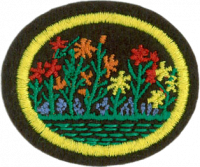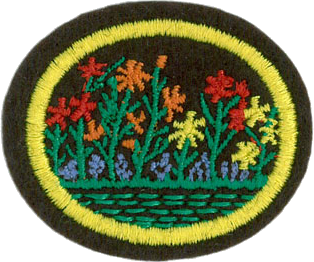Difference between revisions of "AY Honors/Flower Culture/Requirements"
Jomegat bot (talk | contribs) m (Add RequirementsHeader) |
m (- Category of Honor Requirements) |
||
| (11 intermediate revisions by 2 users not shown) | |||
| Line 1: | Line 1: | ||
| − | === | + | {{HonorSubpage}} |
| − | + | ||
| − | + | <section begin=Body /> | |
| − | + | ||
| − | + | <b>1. <section begin=req1 /><noinclude><translate><!--T:1--> | |
| − | + | </noinclude>Define each of the following: | |
| − | + | <noinclude></translate></noinclude><section end=req1 /></b> | |
| − | + | ||
| − | + | :<b>a. <section begin=req1a /><noinclude><translate><!--T:2--> | |
| − | + | </noinclude>Perennials | |
| + | <noinclude></translate></noinclude><section end=req1a /></b> | ||
| + | |||
| + | :<b>b. <section begin=req1b /><noinclude><translate><!--T:3--> | ||
| + | </noinclude>Annuals | ||
| + | <noinclude></translate></noinclude><section end=req1b /></b> | ||
| + | |||
| + | :<b>c. <section begin=req1c /><noinclude><translate><!--T:4--> | ||
| + | </noinclude>Biennials | ||
| + | <noinclude></translate></noinclude><section end=req1c /></b> | ||
| + | |||
| + | <b>2. <section begin=req2 /><noinclude><translate><!--T:5--> | ||
| + | </noinclude>Give general instructions for making a hotbed. What is the difference between a hotbed and a cold frame? | ||
| + | <noinclude></translate></noinclude><section end=req2 /></b> | ||
| + | |||
| + | <b>3. <section begin=req3 /><noinclude><translate><!--T:6--> | ||
| + | </noinclude>What is drainage? Of what importance is it? | ||
| + | <noinclude></translate></noinclude><section end=req3 /></b> | ||
| + | |||
| + | <b>4. <section begin=req4 /><noinclude><translate><!--T:7--> | ||
| + | </noinclude>Name three plant pests and tell how to control them. | ||
| + | <noinclude></translate></noinclude><section end=req4 /></b> | ||
| + | |||
| + | <b>5. <section begin=req5 /><noinclude><translate><!--T:8--> | ||
| + | </noinclude>Give instructions for making a window box and tell its use. | ||
| + | <noinclude></translate></noinclude><section end=req5 /></b> | ||
| + | |||
| + | <section begin=challenge /> | ||
| + | <b>6. <section begin=req6 /><noinclude><translate><!--T:9--> | ||
| + | </noinclude>Prepare the soil, fertilize, plant, and grow to maturity three different kinds of annuals. | ||
| + | <noinclude></translate></noinclude><section end=req6 /></b> | ||
| + | <section end=challenge /> | ||
| + | |||
| + | <b>7. <section begin=req7 /><noinclude><translate><!--T:10--> | ||
| + | </noinclude>Care for two or more perennial flowers growing outdoors for one season by fertilizing, watering, weeding, and treating for pests as needed. Maintain a written record with weekly entries, listing work done. | ||
| + | <noinclude></translate></noinclude><section end=req7 /></b> | ||
| + | |||
| + | <b>8. <section begin=req8 /><noinclude><translate><!--T:11--> | ||
| + | </noinclude>Which three plant nutrients are most important to flowering plants? | ||
| + | <noinclude></translate></noinclude><section end=req8 /></b> | ||
| + | |||
| + | <b>9. <section begin=req9 /><noinclude><translate><!--T:12--> | ||
| + | </noinclude>Identify three flowering plants adapted to each of the following conditions: | ||
| + | <noinclude></translate></noinclude><section end=req9 /></b> | ||
| + | |||
| + | :<b>a. <section begin=req9a /><noinclude><translate><!--T:13--> | ||
| + | </noinclude>Shade | ||
| + | <noinclude></translate></noinclude><section end=req9a /></b> | ||
| + | |||
| + | :<b>b. <section begin=req9b /><noinclude><translate><!--T:14--> | ||
| + | </noinclude>Dry soil | ||
| + | <noinclude></translate></noinclude><section end=req9b /></b> | ||
| + | |||
| + | :<b>c. <section begin=req9c /><noinclude><translate><!--T:15--> | ||
| + | </noinclude>Full sun | ||
| + | <noinclude></translate></noinclude><section end=req9c /></b> | ||
| + | |||
| + | :<b>d. <section begin=req9d /><noinclude><translate><!--T:16--> | ||
| + | </noinclude>Moist soil | ||
| + | <noinclude></translate></noinclude><section end=req9d /></b> | ||
| + | |||
| + | <b>10. <section begin=req10 /><noinclude><translate><!--T:17--> | ||
| + | </noinclude>What is the purpose of a soil test? | ||
| + | <noinclude></translate></noinclude><section end=req10 /></b> | ||
| + | |||
| + | <b>11. <section begin=req11 /><noinclude><translate><!--T:18--> | ||
| + | </noinclude>Make a picture collection of ten annuals, five perennials, and two biennials. Label and know the name of each from memory. | ||
| + | <noinclude></translate></noinclude><section end=req11 /></b> | ||
| + | <section end=Body /> | ||
Latest revision as of 22:28, 20 July 2022
1. Define each of the following:
- a. Perennials
- b. Annuals
- c. Biennials
2. Give general instructions for making a hotbed. What is the difference between a hotbed and a cold frame?
3. What is drainage? Of what importance is it?
4. Name three plant pests and tell how to control them.
5. Give instructions for making a window box and tell its use.
6. Prepare the soil, fertilize, plant, and grow to maturity three different kinds of annuals.
7. Care for two or more perennial flowers growing outdoors for one season by fertilizing, watering, weeding, and treating for pests as needed. Maintain a written record with weekly entries, listing work done.
8. Which three plant nutrients are most important to flowering plants?
9. Identify three flowering plants adapted to each of the following conditions:
- a. Shade
- b. Dry soil
- c. Full sun
- d. Moist soil
10. What is the purpose of a soil test?
11. Make a picture collection of ten annuals, five perennials, and two biennials. Label and know the name of each from memory.


